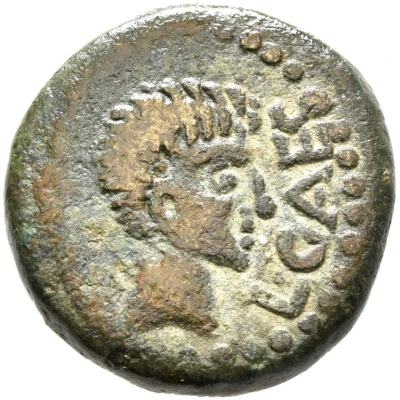


© Bibliothèque nationale de France / Gallica
Semis - Augustus IVLIA TRAD 27 BC - 14 AD
| Bronze | 4.81 g | 19 mm |
| Issuer | Iulia Traducta (Baetica) |
|---|---|
| Emperor | Augustus (Caius Octavius) (27 BC - 14 AD) |
| Type | Standard circulation coin |
| Years | 27 BC - 14 AD |
| Value | Semis (1⁄32) |
| Currency | Denarius (49 BC to AD 215) |
| Composition | Bronze |
| Weight | 4.81 g |
| Diameter | 19 mm |
| Thickness | 2 mm |
| Shape | Round (irregular) |
| Technique | Hammered |
| Demonetized | Yes |
| Updated | 2024-10-10 |
| Numista | N#304866 |
|---|---|
| Rarity index | 91% |
Reverse
Legend and priestly instruments: apex (a cap worn by certain priests) and simpulum (a small vessel or ladle with a long handle, used at sacrifices to make libations)
Script: Latin
Lettering: IVLIA TRAD
Translation: The name "Iulia Traducta" ("transferred Iulia"), refers to the fact that part of the population had been moved from Iulia Constantia Zilitanorum.
Edge
Plain, irregular
Comment
According to roman historian Strabo, between 33 and 25 BC part of the population of the North African city of Colonia Iulia Constantia Zilitanorum (Zilis) was moved to the Iberian peninsula and settled at Iulia Traducta, Betica (Andalusia), Hispania. The location of the city of Iulia Traducta has been widely debated by historians. The latest research and the discovery of several important archaeological sites in the city of Algeciras, Cadiz province, in modern Spain locate the town of Iulia Traducta in the Bay of Algeciras, facing Gibraltar.The coin is not fully dated, corresponding to Octavian Augustus reign (27BC to 14 AD). Some sources give a date 15-14 BC as more probable since Augustus visited the region in 15 - 14 B.C.
Size and weight for this coin vary considerably, from 17 to 21 mm and 3.70 to 5.40 g.
The coin exists in different lettering configurations on the reverse, with IVLIA TRAD minted in clockwise internal reading and counterclockwise external reading, as in the following pictures:
Interesting fact
One interesting fact about this coin is that it features an image of Augustus, the first Roman Emperor, on one side, and a depiction of a bull on the other. This is significant because the bull was a symbol of strength and fertility in ancient Roman culture, and its inclusion on the coin may have been meant to convey the idea of Augustus' powerful and prosperous reign. Additionally, the use of bronze as the material for the coin was a common practice during this time period, as it was a durable and widely available metal.



